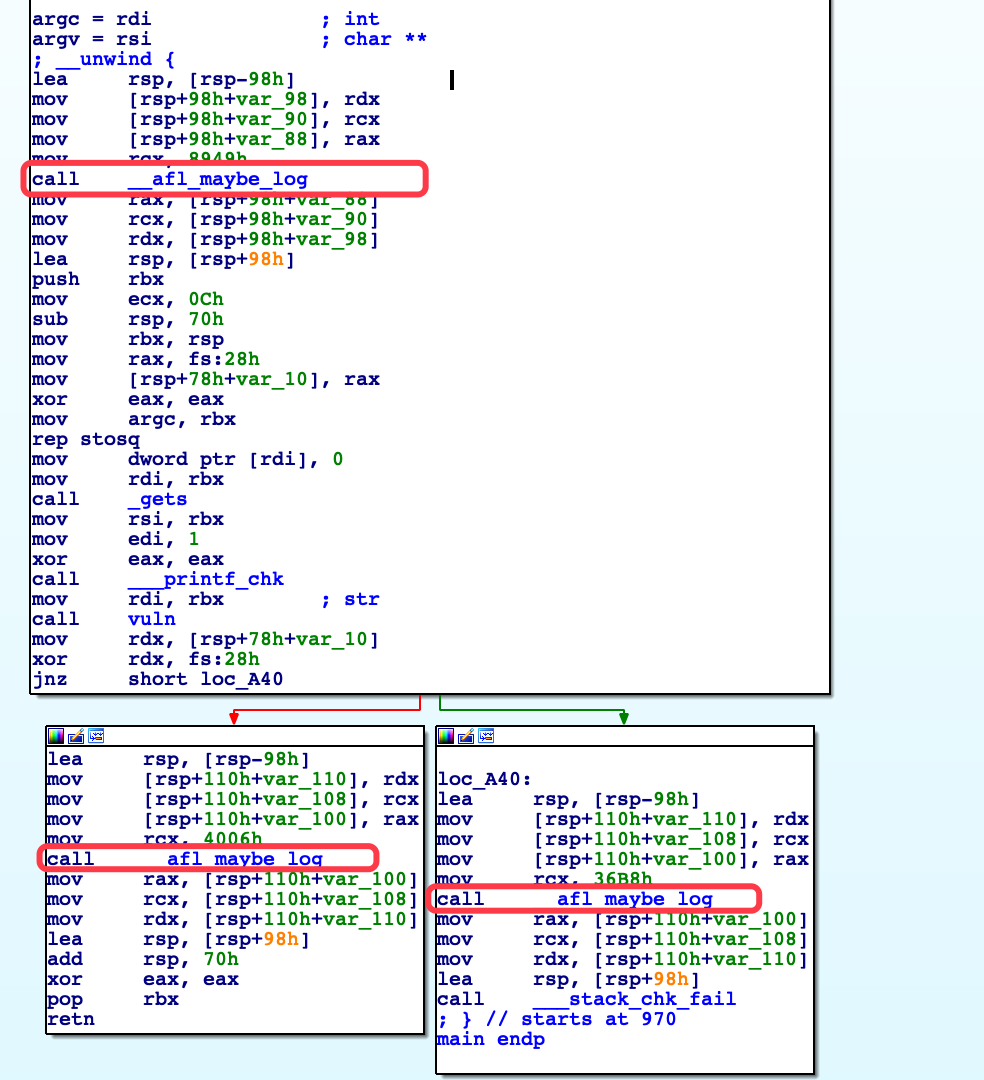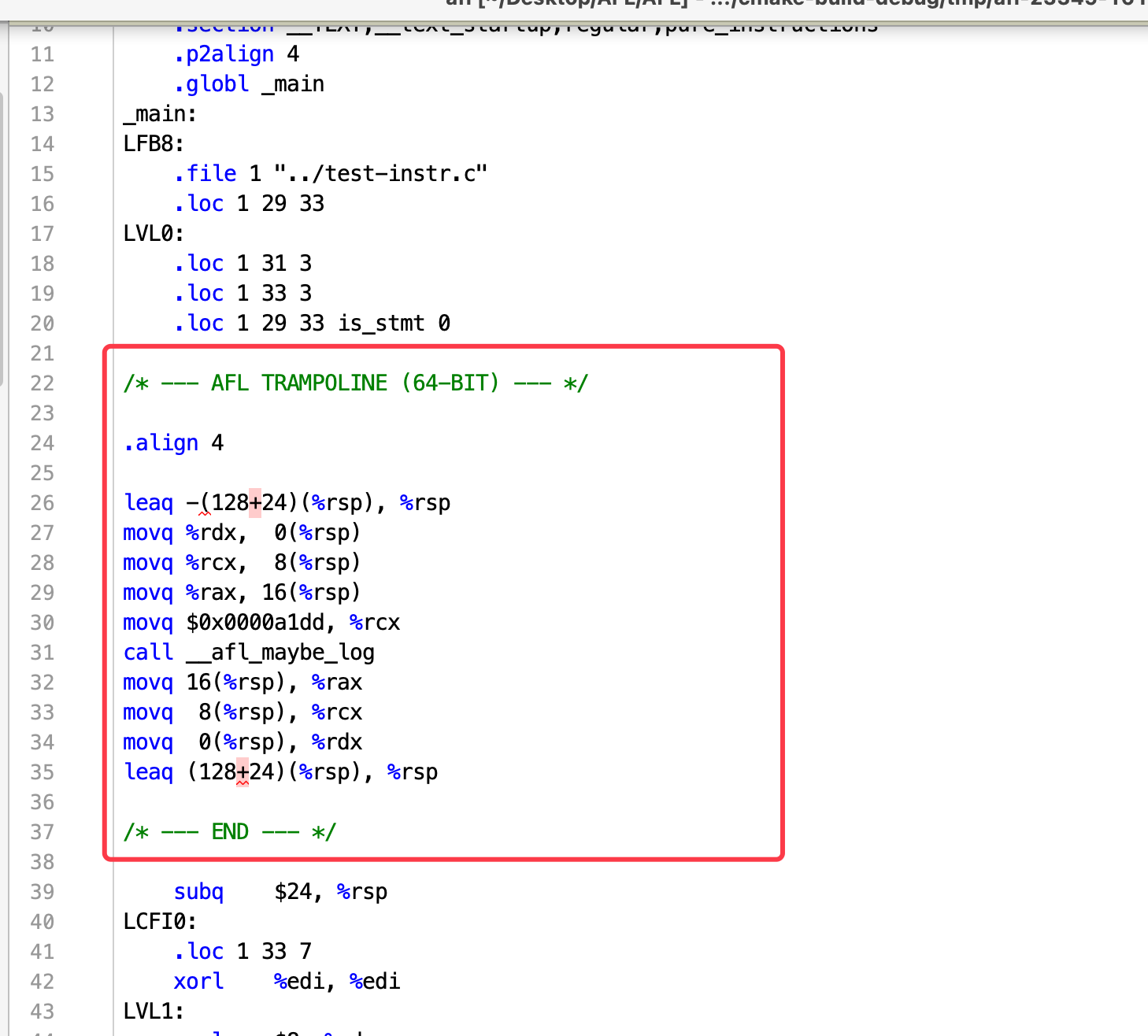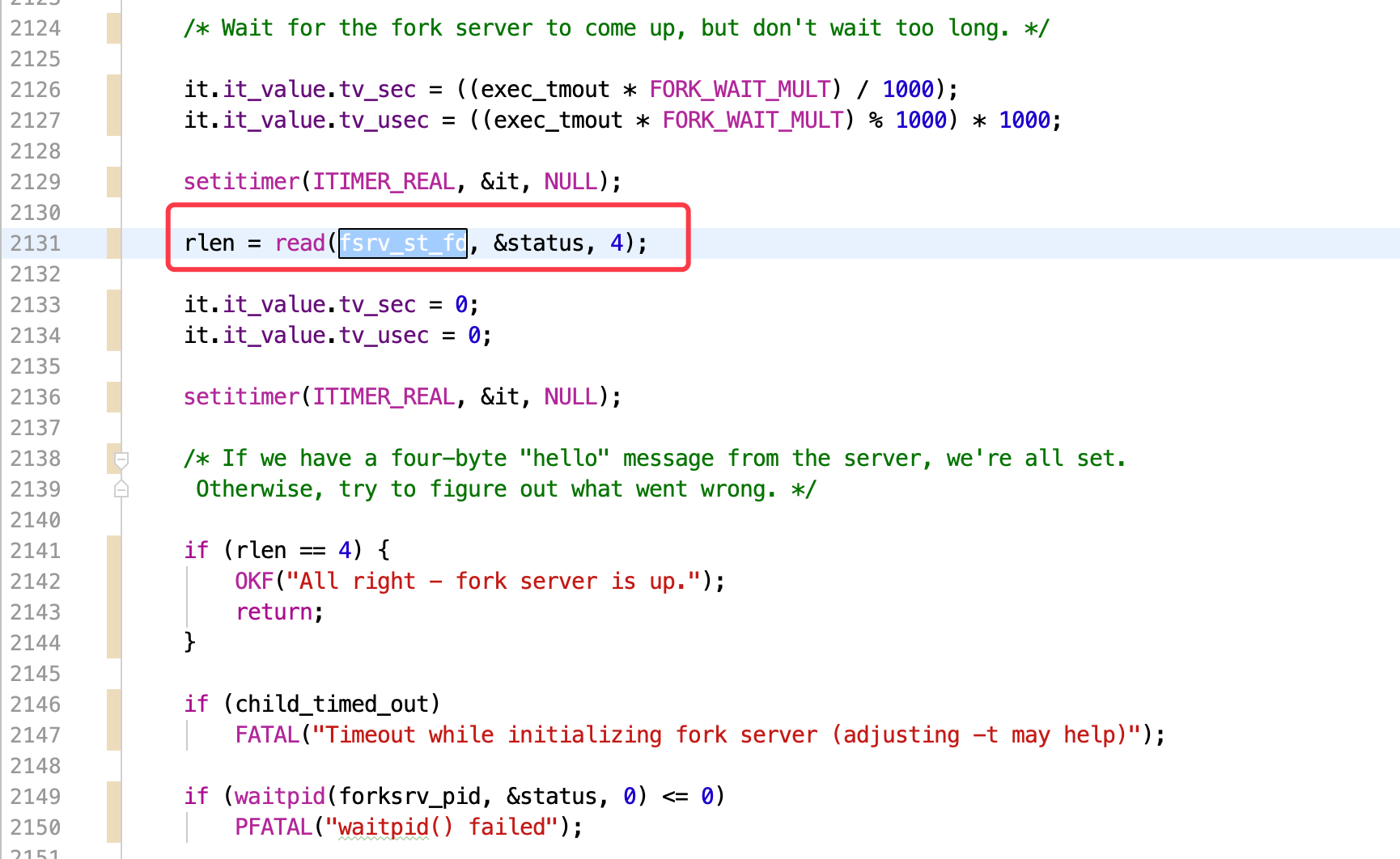AFL的编译插桩是在afl-as部分完成的。本部分主要介绍afl-as以及相关编译插桩的内容。
本篇是afl源码阅读的第二篇,在上一篇我没有主要介绍插桩相关的内容,放在这一章来简单讲一下。
在本篇之后还会有最后一篇第三篇来介绍AFL的 LLVM 优化的相关内容。
首先我们不去看源码,直接先看一下插桩后的样子。
我们使用一个很简单的程序

可以看到这里已经显示了 Instrumented 10 locations

我们将其拉入IDA看一下。


可以看到afl在代码段进行了插桩,主要是 __afl_maybe_log 函数,用来探测、反馈程序此时的状态。
main函数主要做了一下几步
到了真正插桩的部分了,首先明确,afl只在.text段插桩。所以先要找到.text的位置,并在对应的位置设置instr_ok = 1代表找到了一个位置。
首先我们跳过所有的标签、宏、注释。
在这里我们判断读入的这一行line是否以"\t."开头。(即尝试匹配.s中声明的段)
接下来判断一些其他信息,比如att汇编还是intel汇编,设置对应标志位。
AFL尝试抓住一些能标志程序变化的重要的部分:
稍微总结一下就是,AFL试图抓住:_main:(这是必然会插桩的位置)、以及gcc和clang下的分支标记,并且还有条件跳转分支。这几个关键的位置是其着重关注的。
如果是形如:\tj[^m].的指令,即条件跳转指令,并且R(100)产生的随机数小于插桩密度inst_ratio,那么直接使用fprintf将trampoline_fmt_64(插桩部分的指令)写入文件。写入大小为小于MAP_SIZE的随机数。R(MAP_SIZE)
然后插桩计数ins_lines加一。continue
接下来也是对于label的相关评估,有一些label可能是一些分支的目的地,需要自己的评判。
首先判断line中是否有形如类似:^L.*\d(:$)的字符串(比如"Ltext0:")
而如果只匹配到了line中存在":"但line并非以L开头。那么说明是Function label。
此时设置instrument_next = 1进行插桩。
这一切进行完之后,回到while函数的下一个循环中。而在下一个循环的开头,对于以deferred mode进行插桩的位置进行了真正的插桩处理。
这里关键的两个判断:instr_ok && instrument_next,如果在代码段中,且设置了以deferred mode进行插桩,那么就在这个地方进行插桩,写入trampoline_fmt_64。
插桩完毕后生成的.s文件如图:

可以看到已经被插桩了。这里也就是我们一开始看到的:__afl_maybe_log
在插桩结束后,我们把参数打印一下:

可以看到这里在用汇编器as来将我们插桩好的.s文件生成可执行文件。
而真正的汇编过程是fork出一个子进程来执行的。
main函数中等待子进程执行完毕后退出。
至此整个插桩过程就结束了。
在上一部分我们已经知道了,64位下AFL将trampoline_fmt_64写入.s文件的指定位置作为插桩。
本部分主要来讨论AFL究竟插进去了什么东西。
我们直接看ida中的内容,非常直观,trampoline_fmt_64就是如下汇编:
大体流程如下:

在这之前我们首先要关注几个位于bss段的变量:
首先lahf用于将标志寄存器的低八位送入AH,即将标志寄存器FLAGS中的SF、ZF、AF、PF、CF五个标志位分别传送到累加器AH的对应位(八位中有三位是无效的)。

接下来seto溢出置位。
然后检查共享内存是否已经被设置了。即__afl_area_ptr是否为空?
在__afl_setup:中用于初始化__afl_area_ptr,只有在运行到第一个桩时会进行本次初始化。
如果afl_setup_failure不为0的话,直接跳转到afl_return返回。
接下来检查afl_global_area_ptr文件指针是否为NULL,如果为空则跳转到```afl_setup_first```。
否则将afl_global_area_ptr的值赋给afl_area_ptr后跳转到__afl_store
1.在__afl_setup_first中,首先保存寄存器的值(包括xmm寄存器组)
2.接下来进行rsp对齐操作。
3.获取环境变量"__AFL_SHM_ID"的值(共享内存的id)。如果获取失败,那么跳转到__afl_setup_abort,说明获取失败。
4.获取成功后调用shmat启用对共享内存的访问。如果启用失败,跳转到__afl_setup_abort。
5.将shmat返回的共享内存的地址存储在 __afl_area_ptr 与 __afl_global_area_ptr全局变量中。
6.一切顺利的话,接下来运行 __afl_forkserver
首先向FORKSRV_FD+1即199号描述符(即状态管道)中写出__afl_temp中的四个字节,来通知afl我们的fork server已经启动成功。
顺带一提,这里的向状态管道中写的值,在afl-fuzz.c中的这个位置被读出来:

这样我们整个过程就串连起来了。
接下来进入:__afl_fork_wait_loop:
1.首先我们等待parent(fuzz)通过控制管道发来的命令,读入__afl_temp中。
2.如果读取失败,那么跳到 __afl_die,break出循环。
3._fork出一个子进程,子进程跳入执行:__afl_fork_resume
4.将fork出来的子进程pid赋值给__afl_fork_pid
5.向状态管道中写出子进程pid,告知parent。此时__afl_maybe_log中的父进程作为forksrever与我们的fuzz进行通信。
6.等待我们fork出的子进程执行完毕。然后写入状态管道告知fuzz。
7.重新执行下一轮 __afl_fork_wait_loop进行测试。
1.首先关闭子进程中的文件描述符。
2.恢复子进程的寄存器状态。
3.跳转执行__afl_store
这一部分反编译出来如下:
而这个a2就是我们在调用_afl_maybe_log时传入的参数rcx
char __usercall _afl_maybe_log@<al>(char a1@<of>, __int64 a2@<rcx>。
可以看到这个rcx实际就是我们此时用于标记当前这个桩的随机数,而_afl_prev_loc就是上一个桩的随机数
两次异或之后_afl_prev_loc=a2,然后将_afl_prev_loc右移1位为新的_afl_prev_loc。
最后在共享内存中存储当前插桩位置的地方计数加一,相当于:share_mem[_afl_prev_loc ^ a2]++,实际上是存入一个64k大小的哈希表,存在碰撞几率,但是问题不大。而这个索引是通过异或得到的。
更进一步的,关于为什么要对_afl_prev_loc = _afl_prev_loc >> 1;进行右移1位。
AFL主要考虑如下情况:如果此分支是A->A和B->B这样的情况那么异或之后就会都变成0,进而使得无法区分。亦或者考虑:A->B与B->A的情况,异或后的key也是一样的,难以区分。
至此,AFL的插桩就基本分析的差不多了。下一篇会着重讲llvm mode
int vuln(char *str)
{
int len = strlen(str);
if(str[0] == 'A' && len == 66)
{
raise(SIGSEGV);
//如果输入的字符串的首字符为A并且长度为66,则异常退出
}
else if(str[0] == 'F' && len == 6)
{
raise(SIGSEGV);
//如果输入的字符串的首字符为F并且长度为6,则异常退出
}
else
{
printf("it is good!\n");
}
return 0;
}
int main(int argc, char *argv[])
{
char buf[100]={0};
gets(buf);//存在栈溢出漏洞
printf(buf);//存在格式化字符串漏洞
vuln(buf);
return 0;
}
int vuln(char *str)
{
int len = strlen(str);
if(str[0] == 'A' && len == 66)
{
raise(SIGSEGV);
//如果输入的字符串的首字符为A并且长度为66,则异常退出
}
else if(str[0] == 'F' && len == 6)
{
raise(SIGSEGV);
//如果输入的字符串的首字符为F并且长度为6,则异常退出
}
else
{
printf("it is good!\n");
}
return 0;
}
int main(int argc, char *argv[])
{
char buf[100]={0};
gets(buf);//存在栈溢出漏洞
printf(buf);//存在格式化字符串漏洞
vuln(buf);
return 0;
}
if (line[0] == '\t' && line[1] == '.') {
/* OpenBSD puts jump tables directly inline with the code, which is
a bit annoying. They use a specific format of p2align directives
around them, so we use that as a signal. */
if (!clang_mode && instr_ok && !strncmp(line + 2, "p2align ", 8) &&
isdigit(line[10]) && line[11] == '\n')
skip_next_label = 1;
if (!strncmp(line + 2, "text\n", 5) ||
!strncmp(line + 2, "section\t.text", 13) ||
!strncmp(line + 2, "section\t__TEXT,__text", 21) ||
!strncmp(line + 2, "section __TEXT,__text", 21)) {
instr_ok = 1;
continue;
}
if (!strncmp(line + 2, "section\t", 8) ||
!strncmp(line + 2, "section ", 8) ||
!strncmp(line + 2, "bss\n", 4) ||
!strncmp(line + 2, "data\n", 5)) {
instr_ok = 0;
continue;
}
}
if (line[0] == '\t' && line[1] == '.') {
/* OpenBSD puts jump tables directly inline with the code, which is
a bit annoying. They use a specific format of p2align directives
around them, so we use that as a signal. */
if (!clang_mode && instr_ok && !strncmp(line + 2, "p2align ", 8) &&
isdigit(line[10]) && line[11] == '\n')
skip_next_label = 1;
if (!strncmp(line + 2, "text\n", 5) ||
!strncmp(line + 2, "section\t.text", 13) ||
!strncmp(line + 2, "section\t__TEXT,__text", 21) ||
!strncmp(line + 2, "section __TEXT,__text", 21)) {
instr_ok = 1;
continue;
}
if (!strncmp(line + 2, "section\t", 8) ||
!strncmp(line + 2, "section ", 8) ||
!strncmp(line + 2, "bss\n", 4) ||
!strncmp(line + 2, "data\n", 5)) {
instr_ok = 0;
continue;
}
}
If we're in the right mood for instrumenting, check for function
names or conditional labels. This is a bit messy, but in essence,
we want to catch:
^main: - function entry point (always instrumented)
^.L0: - GCC branch label
^.LBB0_0: - clang branch label (but only in clang mode)
^\tjnz foo - conditional branches
...but not:
^
^
^.Ltmp0: - clang non-branch labels
^.LC0 - GCC non-branch labels
^.LBB0_0: - ditto (when in GCC mode)
^\tjmp foo - non-conditional jumps
Additionally, clang and GCC on MacOS X follow a different convention
with no leading dots on labels, hence the weird maze of
later on.
If we're in the right mood for instrumenting, check for function
names or conditional labels. This is a bit messy, but in essence,
we want to catch:
^main: - function entry point (always instrumented)
^.L0: - GCC branch label
^.LBB0_0: - clang branch label (but only in clang mode)
^\tjnz foo - conditional branches
...but not:
^
^
^.Ltmp0: - clang non-branch labels
^.LC0 - GCC non-branch labels
^.LBB0_0: - ditto (when in GCC mode)
^\tjmp foo - non-conditional jumps
Additionally, clang and GCC on MacOS X follow a different convention
with no leading dots on labels, hence the weird maze of
later on.
/* Conditional branch instruction (jnz, etc). We append the instrumentation
right after the branch (to instrument the not-taken path) and at the
branch destination label (handled later on). */
if (line[0] == '\t') {
if (line[1] == 'j' && line[2] != 'm' && R(100) < inst_ratio) {
fprintf(outf, use_64bit ? trampoline_fmt_64 : trampoline_fmt_32,
R(MAP_SIZE));
ins_lines++;
}
continue;
}
/* Conditional branch instruction (jnz, etc). We append the instrumentation
right after the branch (to instrument the not-taken path) and at the
branch destination label (handled later on). */
if (line[0] == '\t') {
if (line[1] == 'j' && line[2] != 'm' && R(100) < inst_ratio) {
fprintf(outf, use_64bit ? trampoline_fmt_64 : trampoline_fmt_32,
R(MAP_SIZE));
ins_lines++;
}
continue;
}
/* Label of some sort. This may be a branch destination, but we need to
tread carefully and account for several different formatting
conventions. */
/* Apple: L<whatever><digit>: */
if ((colon_pos = strstr(line, ":"))) {
if (line[0] == 'L' && isdigit(*(colon_pos - 1))) {
/* .L0: or LBB0_0: style jump destination */
/* Apple: L<num> / LBB<num> */
if ((isdigit(line[1]) || (clang_mode && !strncmp(line, "LBB", 3)))
&& R(100) < inst_ratio) {
if (!skip_next_label) instrument_next = 1; else skip_next_label = 0;
}
} else {
/* Function label (always instrumented, deferred mode). */
instrument_next = 1;
}
/* Label of some sort. This may be a branch destination, but we need to
tread carefully and account for several different formatting
conventions. */
/* Apple: L<whatever><digit>: */
if ((colon_pos = strstr(line, ":"))) {
if (line[0] == 'L' && isdigit(*(colon_pos - 1))) {
/* .L0: or LBB0_0: style jump destination */
/* Apple: L<num> / LBB<num> */
if ((isdigit(line[1]) || (clang_mode && !strncmp(line, "LBB", 3)))
&& R(100) < inst_ratio) {
if (!skip_next_label) instrument_next = 1; else skip_next_label = 0;
}
} else {
/* Function label (always instrumented, deferred mode). */
instrument_next = 1;
}
/* In some cases, we want to defer writing the instrumentation trampoline
until after all the labels, macros, comments, etc. If we're in this
mode, and if the line starts with a tab followed by a character, dump
the trampoline now. */
if (!pass_thru && !skip_intel && !skip_app && !skip_csect && instr_ok &&
instrument_next && line[0] == '\t' && isalpha(line[1])) {
fprintf(outf, use_64bit ? trampoline_fmt_64 : trampoline_fmt_32,
R(MAP_SIZE));
instrument_next = 0;
ins_lines++;
}
/* In some cases, we want to defer writing the instrumentation trampoline
until after all the labels, macros, comments, etc. If we're in this
mode, and if the line starts with a tab followed by a character, dump
the trampoline now. */
if (!pass_thru && !skip_intel && !skip_app && !skip_csect && instr_ok &&
instrument_next && line[0] == '\t' && isalpha(line[1])) {
fprintf(outf, use_64bit ? trampoline_fmt_64 : trampoline_fmt_32,
R(MAP_SIZE));
instrument_next = 0;
ins_lines++;
}
if (!(pid = fork())) {
execvp(as_params[0], (char **) as_params);
FATAL("Oops, failed to execute '%s' - check your PATH", as_params[0]);
}
if (!(pid = fork())) {
execvp(as_params[0], (char **) as_params);
FATAL("Oops, failed to execute '%s' - check your PATH", as_params[0]);
}
lea rsp, [rsp-98h]
mov [rsp+98h+var_98], rdx
mov [rsp+98h+var_90], rcx
mov [rsp+98h+var_88], rax
mov rcx, 46A1h ;注意这里46A1h就是在fptintf插桩的时候R(MAP_SIZE)产生的随机数,可以用于区分每个桩
call __afl_maybe_log
mov rax, [rsp+98h+var_88]
mov rcx, [rsp+98h+var_90]
mov rdx, [rsp+98h+var_98]
lea rsp, [rsp+98h]
lea rsp, [rsp-98h]
mov [rsp+98h+var_98], rdx
mov [rsp+98h+var_90], rcx
mov [rsp+98h+var_88], rax
mov rcx, 46A1h ;注意这里46A1h就是在fptintf插桩的时候R(MAP_SIZE)产生的随机数,可以用于区分每个桩
call __afl_maybe_log
mov rax, [rsp+98h+var_88]
mov rcx, [rsp+98h+var_90]
mov rdx, [rsp+98h+var_98]
lea rsp, [rsp+98h]
.AFL_VARS:
.comm __afl_area_ptr, 8
.comm __afl_prev_loc, 8
.comm __afl_fork_pid, 4
.comm __afl_temp, 4
.comm __afl_setup_failure, 1
.comm __afl_global_area_ptr, 8, 8
.AFL_VARS:
.comm __afl_area_ptr, 8
.comm __afl_prev_loc, 8
.comm __afl_fork_pid, 4
.comm __afl_temp, 4
.comm __afl_setup_failure, 1
.comm __afl_global_area_ptr, 8, 8
__afl_maybe_log:
lahf
seto %al
/* Check if SHM region is already mapped. */
movq __afl_area_ptr(%rip), %rdx
testq %rdx, %rdx
je __afl_setup
__afl_maybe_log:
lahf
seto %al
/* Check if SHM region is already mapped. */
movq __afl_area_ptr(%rip), %rdx
testq %rdx, %rdx
je __afl_setup
__afl_setup:
/* Do not retry setup if we had previous failures. */
cmpb $0, __afl_setup_failure(%rip)
jne __afl_return
/* Check out if we have a global pointer on file. */
movq __afl_global_area_ptr(%rip), %rdx
testq %rdx, %rdx
je __afl_setup_first
movq %rdx, __afl_area_ptr(%rip)
jmp __afl_store
__afl_setup:
/* Do not retry setup if we had previous failures. */
cmpb $0, __afl_setup_failure(%rip)
jne __afl_return
/* Check out if we have a global pointer on file. */
movq __afl_global_area_ptr(%rip), %rdx
testq %rdx, %rdx
je __afl_setup_first
movq %rdx, __afl_area_ptr(%rip)
jmp __afl_store
__afl_setup_first:
/* Save everything that is not yet saved and that may be touched by
getenv() and several other libcalls we'll be relying on. */
leaq -352(%rsp), %rsp
movq %rax, 0(%rsp)
movq %rcx, 8(%rsp)
movq %rdi, 16(%rsp)
movq %rsi, 32(%rsp)
movq %r8, 40(%rsp)
movq %r9, 48(%rsp)
movq %r10, 56(%rsp)
movq %r11, 64(%rsp)
movq %xmm0, 96(%rsp)
movq %xmm1, 112(%rsp)
movq %xmm2, 128(%rsp)
movq %xmm3, 144(%rsp)
movq %xmm4, 160(%rsp)
movq %xmm5, 176(%rsp)
movq %xmm6, 192(%rsp)
movq %xmm7, 208(%rsp)
movq %xmm8, 224(%rsp)
movq %xmm9, 240(%rsp)
movq %xmm10, 256(%rsp)
movq %xmm11, 272(%rsp)
movq %xmm12, 288(%rsp)
movq %xmm13, 304(%rsp)
movq %xmm14, 320(%rsp)
movq %xmm15, 336(%rsp)
/* Map SHM, jumping to __afl_setup_abort if something goes wrong. */
/* The 64-bit ABI requires 16-byte stack alignment. We'll keep the
original stack ptr in the callee-saved r12. */
pushq %r12
movq %rsp, %r12
subq $16, %rsp
andq $0xfffffffffffffff0, %rsp
leaq .AFL_SHM_ENV(%rip), %rdi
call _getenv
testq %rax, %rax
je __afl_setup_abort
movq %rax, %rdi
call _atoi
xorq %rdx, %rdx /* shmat flags */
xorq %rsi, %rsi /* requested addr */
movq %rax, %rdi /* SHM ID */
call _shmat
cmpq $-1, %rax
je __afl_setup_abort
/* Store the address of the SHM region. */
movq %rax, %rdx
movq %rax, __afl_area_ptr(%rip)
movq %rax, __afl_global_area_ptr(%rip)
movq %rax, %rdx
__afl_setup_first:
/* Save everything that is not yet saved and that may be touched by
getenv() and several other libcalls we'll be relying on. */
leaq -352(%rsp), %rsp
movq %rax, 0(%rsp)
movq %rcx, 8(%rsp)
movq %rdi, 16(%rsp)
movq %rsi, 32(%rsp)
movq %r8, 40(%rsp)
movq %r9, 48(%rsp)
movq %r10, 56(%rsp)
movq %r11, 64(%rsp)
movq %xmm0, 96(%rsp)
movq %xmm1, 112(%rsp)
movq %xmm2, 128(%rsp)
movq %xmm3, 144(%rsp)
movq %xmm4, 160(%rsp)
movq %xmm5, 176(%rsp)
movq %xmm6, 192(%rsp)
movq %xmm7, 208(%rsp)
movq %xmm8, 224(%rsp)
movq %xmm9, 240(%rsp)
movq %xmm10, 256(%rsp)
movq %xmm11, 272(%rsp)
movq %xmm12, 288(%rsp)
[培训]内核驱动高级班,冲击BAT一流互联网大厂工作,每周日13:00-18:00直播授课